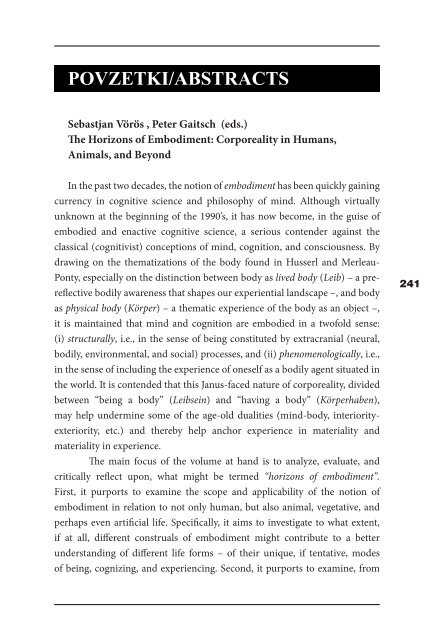phainomena
PHAINOMENA-98-99_e-verzija
PHAINOMENA-98-99_e-verzija
Create successful ePaper yourself
Turn your PDF publications into a flip-book with our unique Google optimized e-Paper software.
POVZETKI/ABSTRACTS<br />
Sebastjan Vörös , Peter Gaitsch (eds.)<br />
The Horizons of Embodiment: Corporeality in Humans,<br />
Animals, and Beyond<br />
In the past two decades, the notion of embodiment has been quickly gaining<br />
currency in cognitive science and philosophy of mind. Although virtually<br />
unknown at the beginning of the 1990’s, it has now become, in the guise of<br />
embodied and enactive cognitive science, a serious contender against the<br />
classical (cognitivist) conceptions of mind, cognition, and consciousness. By<br />
drawing on the thematizations of the body found in Husserl and Merleau-<br />
Ponty, especially on the distinction between body as lived body (Leib) – a prereflective<br />
bodily awareness that shapes our experiential landscape –, and body<br />
as physical body (Körper) – a thematic experience of the body as an object –,<br />
it is maintained that mind and cognition are embodied in a twofold sense:<br />
(i) structurally, i.e., in the sense of being constituted by extracranial (neural,<br />
bodily, environmental, and social) processes, and (ii) phenomenologically, i.e.,<br />
in the sense of including the experience of oneself as a bodily agent situated in<br />
the world. It is contended that this Janus-faced nature of corporeality, divided<br />
between “being a body” (Leibsein) and “having a body” (Körperhaben),<br />
may help undermine some of the age-old dualities (mind-body, interiorityexteriority,<br />
etc.) and thereby help anchor experience in materiality and<br />
materiality in experience.<br />
The main focus of the volume at hand is to analyze, evaluate, and<br />
critically reflect upon, what might be termed “horizons of embodiment”.<br />
First, it purports to examine the scope and applicability of the notion of<br />
embodiment in relation to not only human, but also animal, vegetative, and<br />
perhaps even artificial life. Specifically, it aims to investigate to what extent,<br />
if at all, different construals of embodiment might contribute to a better<br />
understanding of different life forms – of their unique, if tentative, modes<br />
of being, cognizing, and experiencing. Second, it purports to examine, from<br />
241


